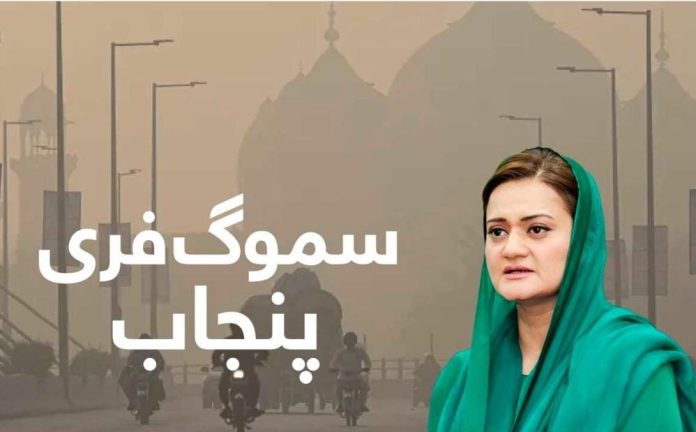Punjab Province, home to 127.691 million people and contributing 52.87% of the national population and 54.2%2 of the national GDP, stands at the forefront of combating air pollution and smog. From October to January, Smog has become Punjab’s “fifth season,” with a thick layer of pollution blanketing urbanized and industrialized cities. Climate-induced weather patterns, with low windspeed, high relative humidity, and temperature inversion, have become significant drivers of the hazy conditions and smog in major cities of Punjab.
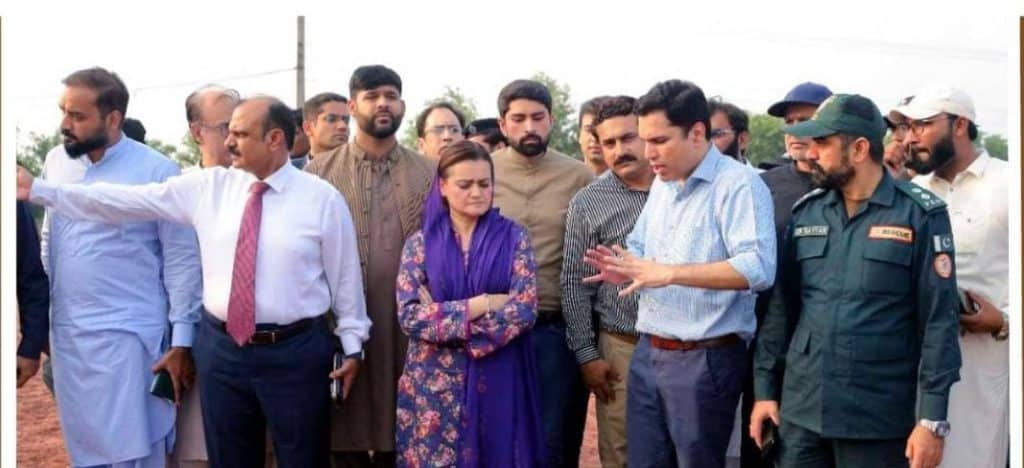
A considerable rise in minimum temperatures leads to a narrowed diurnal temperature range, which is indicative of increased aerosol concentrations. Spatial distribution of air quality pollutants observed through satellite revealed that main urban centers are more prone to air pollution. The rise in smog days, continuous degradation of air quality, insufficient air quality monitoring, and increasing cases of respiratory illnesses and deaths underscore the severity of the situation.
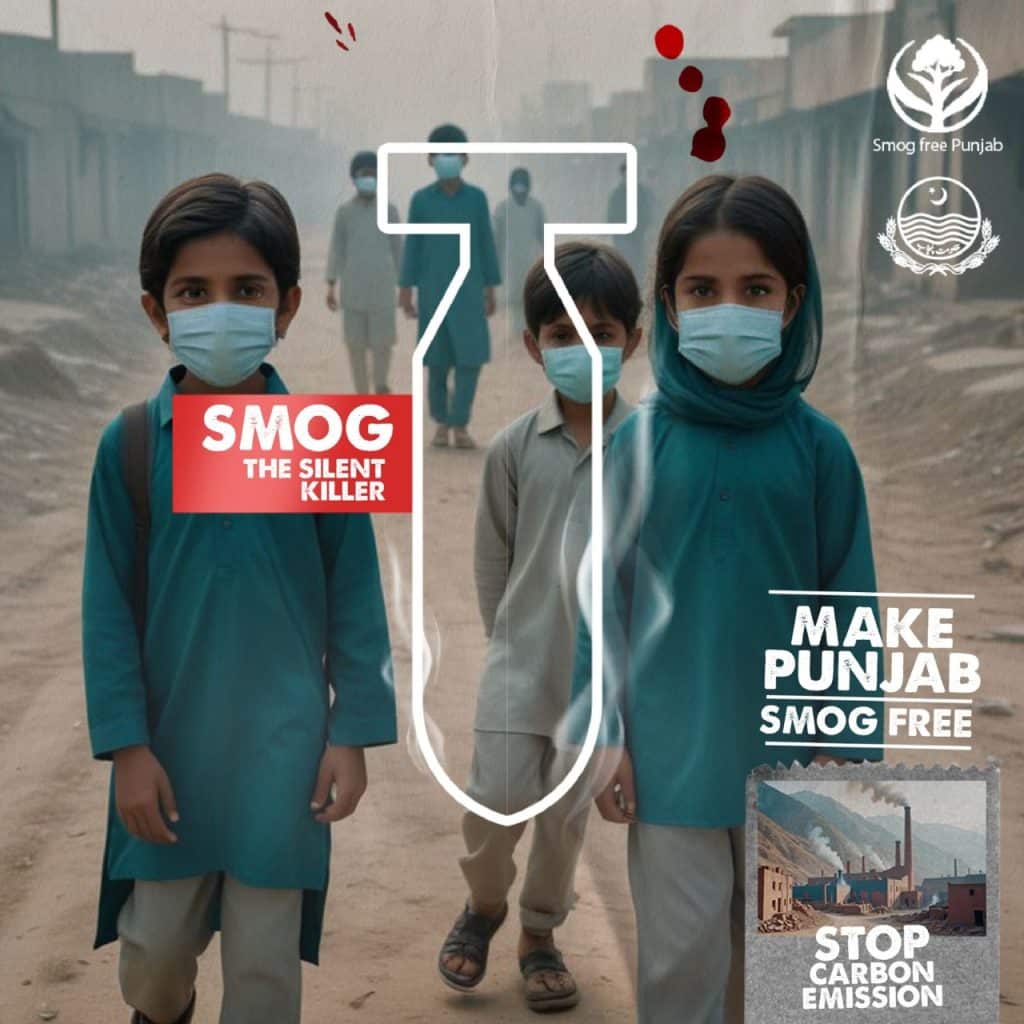
The expanding reach of smog and worsening air pollution in recent years have become a growing concern among the public. The persistent haze and deteriorating air quality are now recognized as major environmental and public health threats.
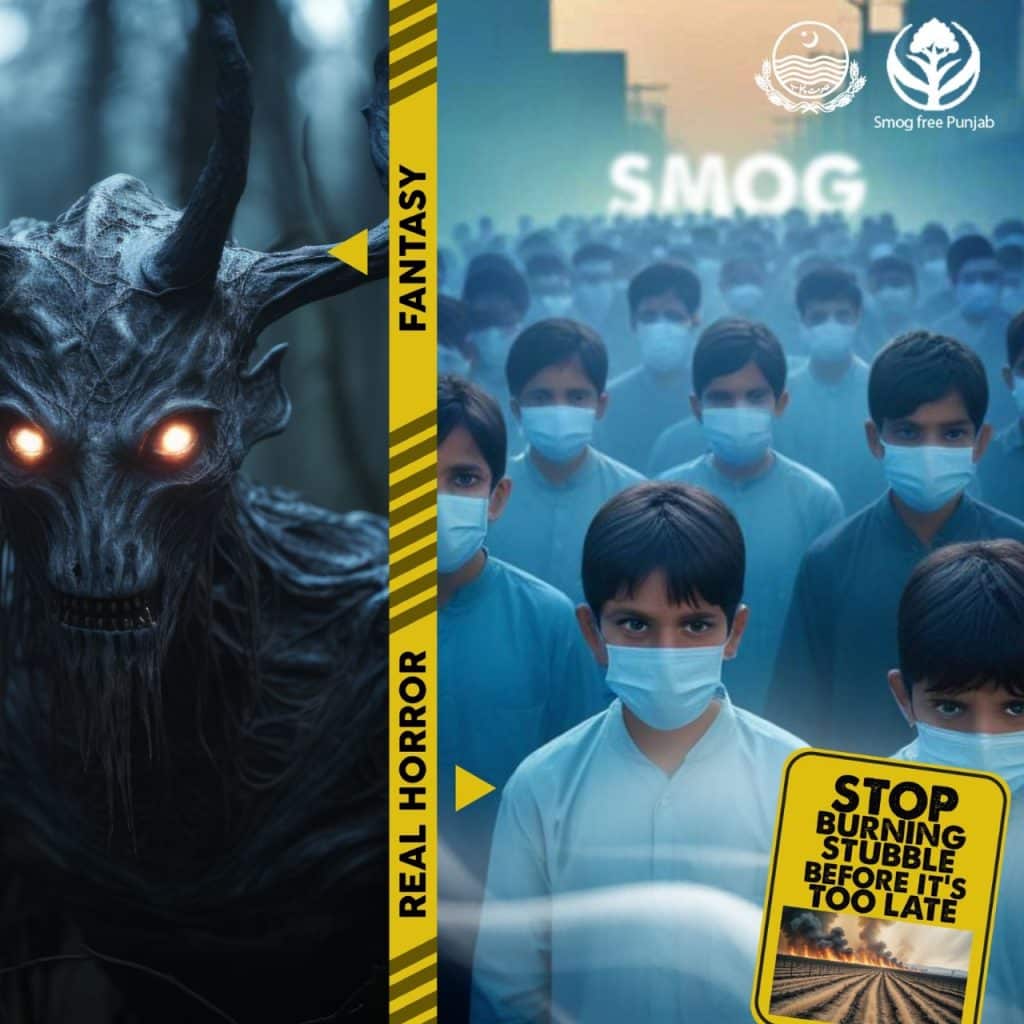
Punjab’s Sectoral Emission Inventory
The sectoral emission inventory of anthropogenic air pollutants in Punjab Province estimated the cumulative emission load in 2020 at 7,017 kilotons per year (kT/Y). Biomass and coal combustion are the primary sources of particulate matter, while liquid fuels are the major contributors to CO, SO2, and NOx emissions.

A cumulative emission inventory for Punjab from 1990 to 2020, evaluated at five-year intervals, reveals a significant upward trend in emissions, indicating worsening air pollution. The findings show that by 2020, emissions had surged to 3.5 times the levels recorded in 1990.
Emission Inventory of Lahore and Pollution Hotspots – AQI Lahore
Lahore, once renowned as the “City of Gardens” for its lush greenery and vibrant landscapes, is now grappling with a severe smog crisis that has transformed its skies into a grey, suffocating blanket. In recent years, air pollution in Lahore has reached alarming levels, with the Air Quality Index (AQI) frequently surpassing hazardous limits, sometimes exceeding 300–400 AQI, far above the safe threshold of Punjab Environmental Quality Standards and those set by World Health Organization (WHO).
According to the 2023 census, Lahore’s population has surged to over 13 million, growing at an annual rate of 3.41%, further straining the city’s infrastructure and increasing vehicular and industrial emissions.
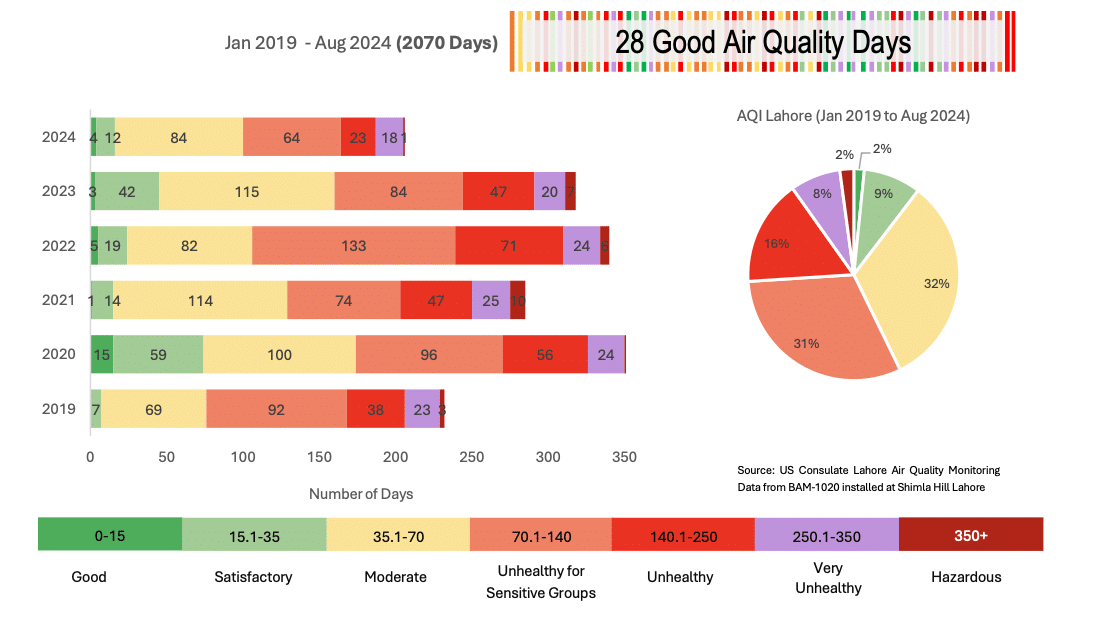
Smog in Lahore is typically at its worst from October to February, with the peak months being November and December. During this period, cooler temperatures, coupled with temperature inversions, trap pollutants close to the ground. This effect is exacerbated by factors such as increased vehicular emissions, industrial activity and stubble burning in surrounding agricultural regions. The lack of wind further prevents the dispersion of pollutants, worsening air quality.
In 2024, the Punjab Government adopted a proactive stance to reduce smog in Lahore. The planning process began as early as April, well before the smog season, with a series of strategic meetings outlining preventive measures.
• In Phase 1, committees were formally established, and all relevant departments were tasked with developing actionable plans.
• The Phase 2 focused on rigorous enforcement, targeting high-emission sectors such as brick kilns and industrial units, ensuring compliance with regulations to mitigate emissions.
• The Phase 3 concentrates on in-season actions aimed at minimizing smog severity during peak periods.
Government Response
In response to the growing challenge of smog in Lahore, Punjab, the government of Punjab is implementing a comprehensive strategy to combat this pressing environmental issue, under the direction of the Chief Minister of Punjab.
Vision:
“A Smog-Less Lahore”
Key Initiatives:
In response to the rising environmental and health concerns caused by smog, Chief Minister Maryam Nawaz has spearheaded a comprehensive Smog Mitigation Plan. This plan incorporates both short-term measures and long- term strategies to significantly reduce air pollution across Punjab. The key initiatives are outlined below:
Smog-Less Punjab Initiative for AQI Lahore
This flagship program aims to tackle pollution at its root through a number of actions;
• Transitioning to greener Mass transit
• Fuel Quality Inspection
• Industrial Monitoring
• Plantation Drives and Urban Forests
• Green Punjab Android App
• Eco Watch Android App
• Smog Helpline
• Drone & Thermal Technologies for Monitoring
• Camera-Mounted Mobile Monitoring unit
Smog Monitoring Unit (SMU) at the Planning and Development Board April 24, 2024 for AQI Lahore
SMU is established under the supervisionof the Chief of Environment and Climate Change at P&DB, consisting of 30 members. It is tasked with adhering to specific TORs to effectively address and manage smog-related challenges. The TORs are as follows:
• Establish a control room in the P&D Board and monitor daily activities on the “Smog Dashboard”
• Coordinate and collaborate through regular meetings for successful implementation of the plan.
• Coordinate and facilitate implementation of the smog mitigation plan by the concerned administrative secretaries of Punjab
• Identify any gaps in the implementation of the Smog plan and ensure redressal of issues.
• Prepare the agenda items for placing before the Standing Committee of the Cabinet on Smog Mitigation for information/ approvals.
• All coordinators shall be responsible for providing the implementation status of the action plan daily to the SMU Cell.
Standing Committee of the Cabinet on Smog Mitigation (SCCSM) May 9, 2024 (AQI Lahore)
The committee is chaired by the Chief Minister of Punjab. Its members include the Senior Minister for P&DB, EPCDD, FWF, and CM Special Initiatives. Additional members are the Ministers for Finance, Industries, Commerce & Investment, Local Government & Community Development, Information & Culture, Specialized Healthcare & Medical Education, Primary & Secondary Healthcare, Communication & Works, Transport & Masstransit, Agriculture, School Education and Energy. The TORs are;
• Assess and Review
• Action Plan Development
• Infrastructure Implementation
• Administrative and Legislative Review
• Task Assignment
• Monitor Progress
• Funding Management
The Committee meets on the first and third Tuesday of each month
Mera Punjab Smog-Free Internship Program
To engage the community, particularly the youth, in environmental protection, the government has launched the Mera Punjab Smog-Free Internship Program. It aims to educate and involve young people in environmental awareness campaigns, particularly around smog reduction.
Bluer Skies – Greener Environment
Government Actions to Reduce Smog and Improve Air Quality
- Strategic Planning
- Enforcement of Smog Mitigation Actions
- Setting-up Institutional Structure
- Education & Awareness
Smog Management Initiatives by the Punjab Government
1. Green Masstransit Program
2. Chief Minister Climate Leadership Development Internship Program
3. Chief Minister Solarization Program
4. CM Initiative of provision of Super Seeders and Rice Shredders to the farmers to control stubble burning
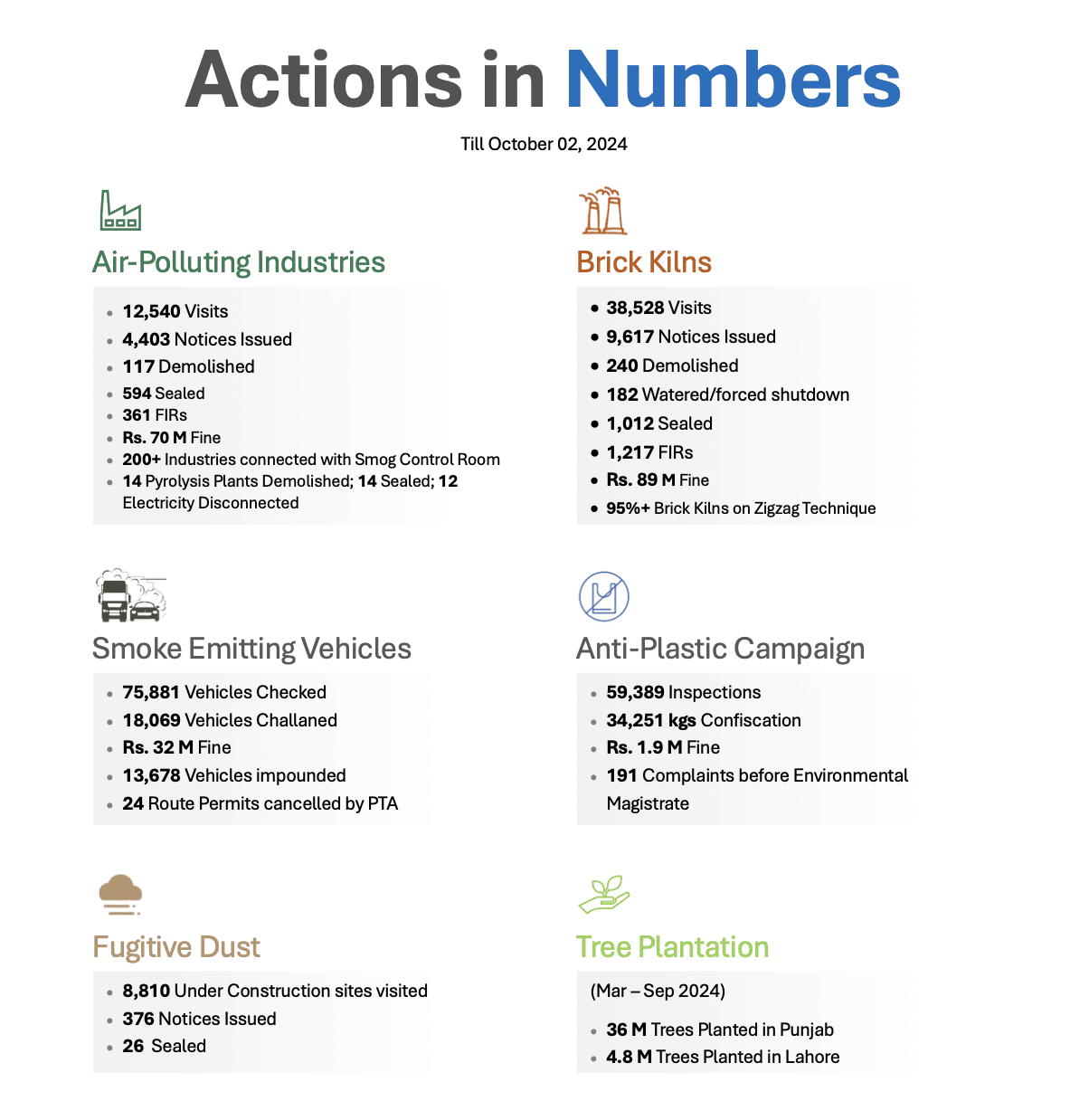
Smog Mitigation Plan
Smog mitigation is a multifaceted challenge that necessitates the collaboration of various sectoral departments due to its cross-cutting nature. Addressing this issue effectively involves coordination across multiple areas, including environmental protection, transportation, agriculture, healthcare, and urban planning. Each sector plays a crucial role in developing and implementing strategies to reduce emissions, enhance air quality, and promote climate resilience. This integrated approach ensures a comprehensive response to the complex factors contributing to smog and supports the development of sustainable solutions across all relevant sectors.
The Government’s Actions for Smog Mitigation revolve around the following sectors;
- Agriculture Sector
- Super Seeding the Future: A Sustainable Solution for Crop Residue Management and Smog Mitigation
- Control of Stubble burning
- Awareness Campaign at Markaz Level
- Transport Sector
- Green Masstransit Program: Driving Punjab Towards a Greener Future
- Legal Amendments
- Provision of 8,200 E-Bikes (Phase – I)
- Vehicle Inspection and Certification System
- Control of Vehicular Pollution
- Procurement and Deployment of Gas Analyzers at Traffic Intersections
- Traffic Congestion and Management at Hotspot Areas
- Traffic Squads of EPA “Environment Protection Agency” (1st ever in Pakistan)
- Punjab Digital Transport Governance Program
- Environment Sector
- Shaping Green Leaders to Combat Smog 3 months internship to 2000 students at Rs 25000 per month
- Mitigation of Fugitive Dust
- Anti-Single-use Plastic Campaign – Ban on Plastics
- Initiation of Night & Sunday Squads and Quick Response Centers
- Collaborations of EPA
- Technological Interventions
- Awareness and Engagements
- Industrial Sector
- Crackdown of Tire Pyrolysis Plants
- No Laxity on Use of Sub-standard Fuel
- Live feed (CCTV) of Industries in Smog Cell
- Drone Surveillance of Industrial Clusters
- Conversion of Brick Kiln into Zig Zag Technology
- Installation of Emission Control Systems (ECS) in industries
- Energy Sector
- Solarization of Public Buildings
- Zero Emission Program
- Pollution reduction from residential cooking
- Research and Academia
- Education Sector
- Conversion of Schools and Colleges into Green Areas
- Awareness Regarding Smog
- Health Sector
- Establish Baseline Survey
- Training and Capacity Building


